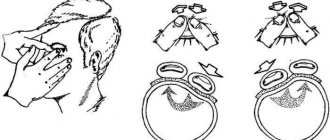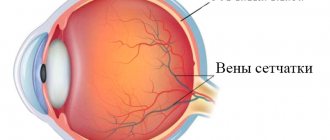Physiological causes of pain
Pregnancy is a direct factor in the fact that vision deteriorates and the eyeballs become inflamed. Already in the first trimester, the synthesis of hormones necessary for the normal course of pregnancy changes. For example, estrogen production decreases, which can cause the mucous surface to dry out. In the early stages, women notice itching in the eyelid area, redness of the apples, and bursting of small blood vessels. Some even develop temporary myopia or farsightedness. As a rule, these problems disappear on their own after childbirth. Interestingly, the symptoms of some eye diseases (such as glaucoma) decrease during pregnancy.
Also, fluid retention as a result of hormonal changes causes degenerative changes in the cornea (thickening, curvature, etc.). If a pregnant woman already wears glasses or contacts, then you need to contact the optician for a more current prescription.
Overwork and physical inactivity can also cause eye pain during pregnancy. In later stages, a woman sits more at a computer or tablet, walks less and turns her gaze from close to distant objects. All these factors lead to vision deterioration and the mucous membrane of the apples to become inflamed.
Another physiological reason is hypertension, which is often found in expectant mothers. Pressure increases not only in the veins and arteries, but also in the eyeballs, which can cause a feeling of fullness and heaviness. Temporary discomfort in the eyes can be caused by headaches and migraines, which often occur in expectant mothers against the background of pressure surges, overwork, toxicosis, or even changes in weather conditions.
Treatment options
Often the disease goes away after childbirth. During pregnancy itself, it is recommended to use glasses instead of contact lenses. Regular gymnastics helps relieve eye fatigue. Doctors recommend reducing time on the computer or other gadgets, and doing exercises for your eyesight during breaks. To remove dryness, you can use Vial eye drops, and Tobrex will save you from conjunctivitis. In addition, you need to eat right, consume more vitamins, minerals and follow a rest regime.
Pathological causes
Decreased immunity, changes in diet and lifestyle lead to the fact that expectant mothers may experience exacerbation of old or new ophthalmological pathologies.
- Deterioration of vision. Degenerative processes in the lens, cornea and retina can lead to weakened visual acuity and the appearance of concomitant diseases.
- Conjunctivitis. Against the background of weakened immunity and hypothermia, inflammation of the mucous membrane may occur. Moreover, it can be either bacterial or viral, or allergic in nature. The expectant mother notes redness of the mucous membrane, cutting pain, and discharge from the corners of the eyes (clear or purulent).
- Foreign objects. The mucous surface of the visual organ becomes drier and more vulnerable during pregnancy, so an eyelash, dust, fluff or other foreign object can easily damage the eye.
- Diseases of the nasopharynx. The organs of vision and breathing are located next to each other, therefore, when the mucous membrane of the nose and sinuses becomes inflamed (rhinitis, sinusitis, sinusitis), the eyeballs hurt during pregnancy.
- Kidney pathologies. In later stages, the uterus can severely put pressure on internal organs, including the kidneys and excretory ducts. As a result, urine stagnates in the organs, causing inflammation and fluid retention in the body. The result is increased swelling in the area around the eyes, which causes discomfort.
Symptoms and treatment of different types of headaches during pregnancy
Tension pain is characterized by a dull, monotonous pain, as if the head is being pulled together with an elastic band.
Patients often complain of pain that spreads from the neck to the back of the head, temples, and eye area. During palpation, painful points are felt in the back of the head and neck. Nausea is possible, but there is no vomiting. The duration of such a headache is from 30 minutes to 1-1.5 hours.
Tension pain occurs during physical and mental fatigue, nervous exhaustion, during or after stressful situations.
Treatment for tension headaches during pregnancy involves relieving symptoms. The following tools will help with this.
1. Glycine reduces psycho-emotional stress and the manifestation of vegetative-vascular dystonia, improves mood, normalizes sleep, and increases mental performance.
Glycine is good to take as a preventive measure for frequent headaches due to instability of the nervous system (during heavy mental work, constant stress, irritability and increased aggression, neuroses, during exams, and so on).
2. In case of overexcitation of the nervous system and sleep disorders, up to 4 Valerian tablets are prescribed at a time.
3. Relaxing aroma balm to cope with mild aching headaches in the area of the temporal lobe and the back of the head. The balm is applied in a small amount to the desired area of the head.
For occipital pain, the balm is first applied to the fingertips, and then a light massage of the scalp in the occipital area is performed.
The composition of the drug is natural, so it will not harm the pregnant woman and her baby. It contains essential oils of lavender, peppermint, anise and rosemary, blue Egyptian chamomile, marjoram, lemon and other plant components.
4. Headex balm stick for headaches will help reduce discomfort without harm to mother and child.
The active component of the balm is menthol, which has long been a natural pain reliever.
Using circular movements, move the balm rod over the skin of your face in the temple area and in the center of the forehead, after which you will feel a pleasant, light cooling sensation. Lightly massage these areas using circular movements.
If necessary, you can repeat the application of the balm after 20 minutes, but no more than 6 times a day.
After using products containing mint and menthol, you should wash your hands thoroughly to avoid getting irritating components into your eyes.
5. “Extraplast” compress patch for headaches associated with migraine (TM Sinsin) contains lavender, eucalyptus, menthol and castor oils. All existing components do not enter the mother’s bloodstream, which means they do not pose a danger to the unborn child.
The cooling patch must be applied to clean and dry skin of the forehead or back of the neck so that it is located outside the area of hair growth and eyebrows. Each patch is not designed for reuse, so if necessary, it must be replaced with a new one. It is recommended to use the patch no more than 6 hours a day.
Symptoms of diseases
If the mucous membrane itches a little and waters, then you need to observe for several days. Perhaps the cause is physiological changes, so the exacerbation will soon pass.
The alarm should be sounded when the following symptoms develop:
- severe pain and pulsation in the eyeballs;
- increased lacrimation, which may be accompanied by discharge from the corners of the eyelids (purulent, cloudy, etc.);
- increased photosensitivity;
- redness and swelling of the eyelids;
- severe itching;
- blurring of objects before the eyes, double vision, spots or dots;
- partial loss of vision;
- high pressure in the eyeballs.
In this case, it is necessary to urgently consult an ophthalmologist to prevent serious illness and significant loss of vision.
Darkening of the eyes during pregnancy
It happens that vision problems signal alarming changes during pregnancy (for example, high blood pressure). You need to pay attention to the following symptoms: blurred vision or temporary absence of vision, double vision, flashes and spots before the eyes. Swelling and puffiness around the eyes is a signal of high blood pressure or kidney dysfunction.
If your eyes become dark during pregnancy, you should definitely inform your doctor about it. In this case, the eyes are not the affected organ, but a catalyst for change. As a rule, eliminating the problem leads to normalization of visual function.
Prevention
If your eyes hurt during pregnancy, you must follow the recommendations of doctors to reduce discomfort.
- Choose the right glasses and contact lenses.
- Reduce the time spent in front of a computer or tablet monitor.
- Walk in the fresh air more often, turning your gaze from near objects to distant ones.
- Rinse your eyes daily with a special antibacterial composition or a weak herbal decoction.
- Moisten the mucous surface with artificial tears drops, which can be found in pharmacies.
- Massage the eyeballs with your fingertips.
Remember that vision may fluctuate while you are expecting a baby, so do not schedule any eye surgery before delivery. The eyes are a very important organ that helps us recognize and experience the world. Particular attention should be paid to them during pregnancy, when all internal systems may malfunction.
Normal eye pressure during pregnancy
The magnitude of intraocular pressure depends on the formation, circulation and outflow of intraocular fluid, as well as on the pressure in the episcleral veins. To assess ophthalmotonus, the following indicators are distinguished:
- statistical norm of IOP;
- individual IOP level;
- target IOP.
The statistical norm depends on the method for determining tone and is approximately 10-24 mm Hg. Art.
An individual level of pressure or tolerant is a pressure that does not have a negative effect on the eye. For example, 20 mm Hg. Art. when determining pressure according to Maklakov, it is considered normal, but for a particular person it can be elevated and will lead to the development of glaucomatous changes in the structures of the eye.
Target IOP is the pressure that must be achieved during treatment so that there is no progression of glaucomatous changes and deterioration of visual functions.
Iphthalmotonus may also differ in the morning and evening; the difference can reach 3 mmHg. Art.
Important! To identify eye diseases accompanied by an increase or decrease in IOP, one cannot rely only on tonometry indicators. It is necessary to carry out a full range of examinations to detect pathological changes associated with the action of intraocular pressure.
Measuring eye pressure during pregnancy
When registering for pregnancy, a woman undergoes a medical examination by various specialists, including an ophthalmologist. When you first visit the ophthalmologist, tonometry is necessary.
Depending on the results of tonometry and general ophthalmological examination, the issue of the frequency of doctor visits is decided. If a woman has no eye complaints, IOP is normal and there are no pathological glaucomatous changes in the eyes, then a repeat examination is scheduled only before childbirth, at approximately 36 weeks.
If there are no complaints or changes in the eyes, but a slight increase or decrease in pressure is detected, then it is necessary to re-measure, preferably the next day. If the indicators are normal, then a re-examination is carried out before birth. If the IOP level remains changed, then a thorough examination is necessary to identify the cause of IOP fluctuations. The frequency of follow-up examinations depends on the identified cause.
Detection of a significant increase or decrease in pressure, the presence of pathological changes in the eyes requires a detailed additional examination of the woman and identification of the cause of the disease. The frequency and frequency of examinations is decided by an ophthalmologist on an individual basis.
During pregnancy, intraocular pressure can be measured in various ways. No method for determining IOP levels affects the child.
The following methods for measuring ophthalmotonus during pregnancy are available:
- palpation;
- applanation tonometry according to Maklakov;
- applanation tonometry according to Goldmann;
- non-contact tonometry.
Each of these methods has its own advantages and disadvantages.
Palpation method
determination of the IOP level is carried out as a preliminary. The doctor uses his fingers through the eyelid to lightly press on the eyeball, determining the IOP level. This procedure suggests the presence of changes as follows:
- if the eye is soft on palpation and there is a feeling of fluctuation, then the IOP is less than 20 mm Hg. Art.;
- if the eyeball has a rocky density, this means that the IOP is significantly increased.
The main disadvantage of this method is the inability to determine boundary states when pressure fluctuations are insignificant.
Applanation tonometry according to Maklakov
is a standard method for determining tone in Russia. It allows you to determine the exact value of IOP and diagnose borderline conditions. Tonometry is performed under local anesthesia in the supine position. A tonometer with dye applied to it is installed on the patient's eye. Then a tonometer imprint is made on paper and the pressure value is determined from the diameter of the mark without dye.
Applanation tonometry according to Goldmann
carried out in a sitting position. The tonometer is attached to the slit lamp. An anesthetic and fluorescein are instilled into the eye, then a tonometer is installed. The pressure value is determined on the scale of the device. This method avoids errors due to the thickness of the cornea and the density of the sclera of the eye.
With non-contact tonometry
the eye is exposed to a stream of air. The tonometer records the degree of corneal deformation and calculates the IOP value. The advantage of this method is the possibility of use even with an inflammatory process in the eyes.
High eye pressure: what should a pregnant woman do?
High eye pressure during pregnancy is extremely rare due to the hormonal characteristics of the woman.
When high eye pressure is detected, it is necessary to find the cause of its increase. To do this, you must undergo a complete ophthalmological examination. For example, the cause of high tone may be previously undiagnosed glaucoma; in this case, an examination is carried out to determine the stage of the disease, and treatment is prescribed. Read about glaucoma during pregnancy.
If a sharp increase in IOP occurs with the development of an attack of glaucoma, then it is necessary to urgently consult a doctor.
Is there a way to prevent high eye pressure?
Prevention of increased ophthalmotonus is aimed at preventing the development of pathological processes in the eyes. To do this you need:
- give up bad habits: alcohol, smoking;
- reduce visual stress;
- walk in the fresh air more often;
- Healthy food.
It is very important to undergo an annual medical examination by an ophthalmologist to identify the initial stages of eye diseases.
Yulia Chernova, ophthalmologist, especially for Mirmam.pro
Hormones are to blame
Hormonal changes in the body. This is the main reason for all the changes that occur in it. The same can be said about vision. During pregnancy, estrogen levels decrease. Therefore, the fluid needed for the normal functioning of the eyes becomes insufficient. This may manifest itself as redness, darkening, and the eyes may even itch. Some women experience problems with farsightedness. Others notice myopia. Still others may have watery eyes. Some pregnant women may even need glasses temporarily! Don't worry: after giving birth, such problems usually disappear.
But there are also more serious situations. Water retention, for example, can cause the cornea to thicken or curve. This is not very significant, but it may well affect the effectiveness of a woman’s glasses and contact lenses. Therefore, during pregnancy you should not have eye surgery or change old lenses, and you should not change glasses by purchasing new ones.
If a woman experiences vision changes during pregnancy, they will most likely be minor. Statistics show that in most cases, after childbirth, all changes return to normal. But, nevertheless, a visit to the ophthalmologist will not be superfluous.
More on the topic
Why does visual acuity decrease after childbirth?
Why can the liver hurt during pregnancy?
Is it possible to avoid toxicosis during pregnancy?
Why might black stool appear during pregnancy and is it worth worrying about?
Why can your stomach itch in early and late pregnancy?
Pregnancy and the retina
During pregnancy, the main threat to the visual system is the condition of the retina. The retina is a thin layer of nerve tissue located on the inside of the back of the eyeball that absorbs light. It is a complex formation, the main one of which is a thin layer of light-sensitive cells - photoreceptors. The retina of the eye is responsible for perceiving the image that is projected onto it using the cornea and lens, and converting it into nerve impulses, which are then transmitted to the brain. The main problems with the retina are: retinal dystrophy, retinal tear, retinal detachment.
To prevent possible eye complications during pregnancy and childbirth, it is necessary to determine in advance the state of the visual system of the expectant mother and be sure to check the retina. Ophthalmologists strongly recommend, regardless of how you see and whether you have vision complaints, at 10-14 weeks of pregnancy
.
In addition to a general examination of the visual system, diagnostics of the fundus with a dilated pupil is mandatory. If the diagnostic results do not reveal any abnormalities, then a repeat examination
vision specialists advise to undergo it closer to the end of pregnancy -
at 32-36 weeks
. However, if you have myopia, then ophthalmologists recommend that you be monitored monthly. During pregnancy, a woman’s entire body undergoes changes, including her vision. Therefore, the visual system requires special attention from the expectant mother.










